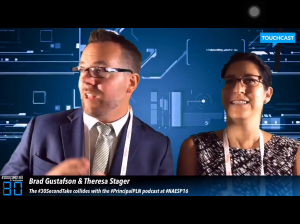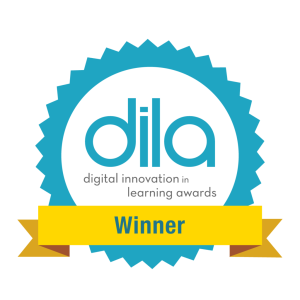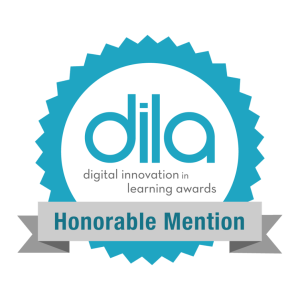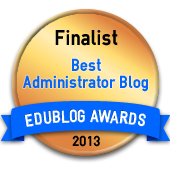Blog Archives
What’s Your One?
Have you ever returned from a conference and been asked to name a “take-away” or something you learned?
I recently had the chance to collaborate on a special podcasting project with Theresa Stager (co-host of the PrincipalPLN podcast). We were both at the NAESP national conference in Maryland and presented a session on podcasting together in the Innovation Lab. Click HERE to view the live NAESP podcast.

During the session and live-podcast, we asked school leaders their “one” takeaway. In addition to hearing what conference attendees were learning, we also wanted to model just how easy starting a podcast can be. (Clearly, we needed to spend a tad more time setting up the green-screen lights, but getting over the need for perfection is a big step to actually starting a podcast!)
I’ve always maintained that one of the best ways for principals to provide relevant instructional leadership is to model using relevant communication platforms like face-to-face conversation, social media, and podcasting. A podcast is also a great way to shine the light on the incredible work students and staff do on a daily basis, so there are many reasons to start.
We hope you enjoyed hearing from the inspiring (and brave) school leaders as they shared their “one” conference takeaway. We also hope that you consider trying podcasting as a school or classroom communication tool.
I’d love to hear what your “one” was from NAESP16 in the comments section below, as well as other reasons you’ve used podcasting in your classroom or school.
**Be sure to hop over to this blog’s new home at www.BradGustafson.com for more Adjusting Course goodness. In less than seven seconds you can subscribe and have the blog delivered right to your virtual doorstep.
The Rush

Image Credit: http://www.dumblittleman.com
There is no shortage of passion in education. Teachers work tirelessly to meet the needs of their students, often sacrificing family time and resources in the process. Their commitment to discover new tools and techniques to make a difference for kids is one of the best untold stories in education.
At the same time, external pressures and conflicting mandates have created some very challenging conditions for teachers. I’ve noticed that all of these factors have perpetuated a rush of sorts.
Notably absent in the rush is a deeper dialog about pedagogy. Educators rush to new ideas in pursuit of different ways to inspire students, or just the opposite. We may rush to repeat the same routines that worked well in previous year(s). Whether we are rushing to bring new opportunities to our students, or confronted by the lure of efficiency that the status quo offers; pedagogy needs to play a more prominent role in the rush.
- Before we rush to [insert educational trend here] we need to reflect upon the purpose.
- Before we rush to [insert past-practice here] we need to consider a more relevant and connected pedagogy.
Communicating precisely what a connected pedagogy is (and is not) becomes vitally important to ensuring we’re rushing to the right (and relevant) things for our students. The short video below is a humorous take on what happens when we say the same thing, but understand it differently than others. Pedagogy is an example of a word that many educators use, but we all understand it differently.
I’ve identified four tenets of a connected pedagogy that will empower educators to do the difficult work they’ve dedicated their lives to. The tenets take the ambiguity out of the term “pedagogy” and illuminate a path that will cultivate skills for today’s learners. The blog posts that I’ve linked to each tenet are basic conversation starters.
When we prioritize purpose and rush to a relevant & connected pedagogy the work becomes more significant.

Image Credit: http://www.brainyquote.com
The Pedagogy of Skydiving
I often hear people talk about the drastic changes needed in education to prepare students for their future. However, I tend to believe that the right people to do the job are already in our schools. To respond to the needs of the 21st century student we need subtle shifts in thinking and pedagogy. These subtle shifts will lead to transformational results.
Just. Like. Skydiving.
I had the opportunity to go indoor skydiving with a couple friends in Chicago recently. Our experience in the immense wind-tunnel was a pure adrenaline rush. Although the skydiving took place indoors the speed and force of the air blasting upwards was very real.
Indoor skydiving wind-tunnels are capable of blasting air that reaches speeds of 175+ mph. I found the mechanics of this high octane sport fascinating. The air speeds are so intense that super slight adjustments to body position can lead to jolting movements.
When I was in the standard neutral belly position (chin up and arms out) a subtle adjustment of my hands could have propelled me into a 360 degree rotation. This subtle shift in my wrists would have been indiscernible to the casual onlooker, but it could have had me resembling a human helicopter blade!
Understanding the impact of subtle shifts is critical in skydiving; it’s critical in education too.
The proper subtle shifts can lead to a transformative experience. Be sure to watch the two minute video of our indoor skydiving adventure that’s embedded above. (The end of the video contains raw footage of our highly trained instructors applying the principle of ‘subtle shifts’ that led to a jaw-dropping aerial acrobatic show.)
What subtle shifts do YOU think our students deserve?
Share your thoughts in the comments section. I started with a few subtle shifts in thinking that will serve our students well:
- How can I enhance the frequency and depth of collaboration in my classroom or school?
- In what ways can I give up more control so that students truly own their learning?
- How might we tap into the transformational power of technology to move beyond the prevailing belief that an interactive whiteboard is the pinnacle of technology integration.
- Am I teaching a lesson or facilitating a lasting learning experience for students?
Flipped Open House
We are extremely excited for our ‘Open House and Community Connections Night’ on September 3rd. This year we are flipping things around a bit! We are sharing some short videos before Open House so that our families have the chance to learn more about our amazing teachers and the curriculum prior to connecting in person.
Directions:
1. Watch the short video promo above. (It’s less than two minutes long.)
2. Go to https://goo.gl/4u7pFV and select the grade-level playlist you’d like to watch. Don’t forget to watch the flipped videos created by Specialists and Administration too.
3. Join us at Open House and Community Connections Night on September 3, 2015. PTA booths open at 3:00pm. Classrooms are open between 4:00 – 6:00pm. Community tables, PTA booths, and Social Media Support will be open in the Cafeteria throughout Open House. We can’t wait to connect!
Additional Resources:
I’m really proud of the extra time our team took to create their curriculum videos. To access each grade-level’s playlist in YouTube click HERE.
To access our ‘Welcome Back’ letter click HERE.
To go to our school’s website with more Open House dates/forms click HERE.
Please let me know if I can help in any way.
When Worlds Collide
Most people are willing to concede the world is changing for the better. Education is changing. I tend to agree and I also think our students would benefit from some additional urgency and intentionality on our part.
We have opportunities to connect and learn from others that were unfathomable a decade ago. We simply need to accelerate the merger between how ‘school’ has always been done and what it needs to be for our kids.
The evolution of technology has unleashed new levels of learning, creativity, content-creation, and sharing. However, pedagogy has not been as nimble. We have barely begun to scratch the surface of how ‘traditional best-practice’ should co-mingle with the digitally connected age. We need these two worlds to collide.
This week I attended an EdCamp Leadership Conference in Chicago where I co-facilitated a session that delved into this very topic. As part of the session we integrated some quadcopters and robotics, but the primary focus was on learning and connectivity.
The picture below doesn’t begin to describe the depth of the conversations that transpired. However, if you click HERE you can read a reflective piece by Jeff Herb who was also part of the session.
The energy and sense of wonderment in the session were palpable. This had me reflecting on the degree to which we are giving traditional best-practice a ‘free pass.’ Are we more prone to question and criticize new ideas, technology, and innovations than we are to examine the status quo? Sometimes it feels as if past-practice has been placed in a protected vacuum chamber that absolves it from any scrutiny whatsoever.
What if we were able to realize a breakthrough and find a way to merge the digitally connected age with best-practice? What if we created a culture of innovation and risk-taking that made it OK to question things we’ve always done in schools?
Analyzing every inefficiency.
Advocating for students before we thought about maintaining the predictable practices we’ve come to accept as the only way.
How far could we go?
How deep would the learning and relevance be?
What’s the best thing that could happen?
Are you with me?!
Why Mindset Matters
It’s a funny thing. All a child really requires to change the world is permission…and maybe a sheet of paper. When we give kids permission to create we unleash a whole new world of possibilities. When we provide kids tools (paper, technology, sticks, whatever) and the conditions to create their inclination is to do just that. All it really takes is removing some of the compliance-based restraints we’ve systematized in our homes and schools.
Our family was recently enjoying lunch together on a local restaurant patio. It was undeniably HOT outside, but the precious sunshine that makes a cameo each summer in Minnesota was too much to pass up. There were also some regular gusts of wind that provided the perfect balance to the scorching sun.
After fielding a few initial complaints about the heat from our children we settled in and ordered some lemonade. It wasn’t more than five minutes later that one of our children began tearing apart her kids’ menu. My visceral reaction would normally include a reminder about restaurant etiquette, but I bit my tongue and proceeded to soak in the rays while enjoying my wife’s company.
It wasn’t long until my daughter produced the creative hat pictured above. I’m not sure if the hat actually provided any semblance of shade, but it did include a chin strap to guard against the sudden bursts of wind that occasionally greeted us over the course of our lunch outside. Needless to say, I was impressed.
Fast-forward to today, where I’m sitting inside listening to a summer rainstorm…
As I occasionally check the stream of tweets coming from the #ISTE15 and #NAESP15 hashtags, a part of me is really excited for what our kids can look forward to this coming school year.
When school resumes in the fall educators will bring back a mindset that has been impacted by a community of educators that will not rest until student creativity is celebrated. They will return to their schools armed with the understanding that the transformative power of technology is something that can actually bring people together.
I know that the educators who are connecting and spending time together at ISTE and NAESP will ultimately bring something more valuable than any device, tablet, or initiative back to their respective schools. “Best-practice” doesn’t start with a tool or tablet, and it’s certainly not a program. Our kids are counting on us to embrace a learner’s mindset. In doing so we may need to unlearn approaches we once held dear. We need to give our students permission to create, make, engineer, paint, invent, tinker, connect, collaborate, and grow.
Our kids are counting on us. This is precisely why mindset matters.
Student-Created Drone Challenge
Our 5th graders recently completed a project using educational drones. The learning experience integrated technology, creative writing, critical thinking, and mathematics (among other important skills). Students worked with one of our technology teachers, Mr. Adam Hinnenkamp, to create original drone challenge courses. You can read about the #EduDroneChallenge project and how your students can participate HERE.
The video below features one group’s project. Kids created an original theme (Medusa’s Lair) and integrated learning targets into their challenge. I’m so proud of our students and continue to be inspired by the collaborative learning experiences our teachers are providing. Sometimes students are so immersed in their work that they express genuine disappointment when they have to go home or outside for recess. They don’t want to stop what they’re working on in school. You gotta love it!
*Note: If you’re receiving this blog post via e-mail you need to go to https://adjustingcourse.wordpress.com/ to view the 1 minute YouTube video posted above. The video documents the drone challenge our students created.
NAESP National Panel on Innovation
We’ve got an NAESP National Panel planned with some spectacular surprises. Join us for a conversation about innovation and connectivity in education. To get to know the presenters before the conference, simply click on the image above or download the DAQRI augmented reality app on a mobile device. (Just hover over the flyer while in the DAQRI app to launch into a 4D experience!)
Date: Wednesday, July 1, 2015
Time: 2:00pm – 3:15pm
Location: Long Beach Convention Center, Room 201B
Presenters Include:
Can’t travel to NAESP in Long Beach? Watch for a Periscope link via Twitter to join us virtually!
What is Innovation?
Innovation can look like many things…but you probably never thought it could be students creating a mini-golf course featuring robotic droids instead of golf balls! Greenwood’s 1st through 5th graders have been busy collaborating on a variety of challenges with the support of a terrific tandem of Technology teachers. The tool of choice is Sphero robots!
Check out the short video below for highlights of their innovation in action!
We believe that if the appropriate support and cutting-edge tools, our students can do more than we ever thought possible. That’s why we’re committed to innovation and cultivating 21st century skills like collaboration, communication, creativity, and critical thinking.
We’ll be adding our 31 Sphero robots to our fleet of Mobile MakerSpace carts in the coming days. Teachers will be able to check out the robots and other MakerSpace carts to support student learning and creativity throughout our school.
A huge thanks to Adam Hinnenkamp and Kate Asmus for helping students to learn the basics of blue-tooth syncing, coding, and more.



















